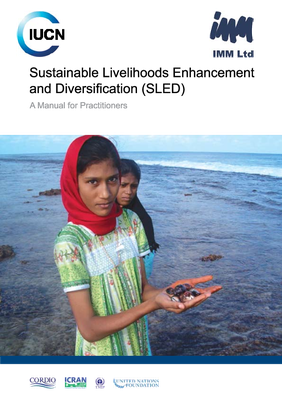Sustainable Livelihoods Enhancement and Diversification (SLED): A Manual for Practitioners

Key points in document
- The manual presents an introduction to the SLED approach.
- As described in the manual, sustainable livelihoods may include conservation enterprises. The guidance provided applies to building the enabling conditions for enterprise groups.
- The manual guides facilitators through the steps of the SLED approach: “Discover, Direction, and Doing.” These steps allow the project planner to understand the conditions within the community and site, to assist groups in building consensus around the need for change, to define their visions, to select livelihood changes suitable to their visions, and to support the group in implementing their livelihood change.
- Case studies on conservation enterprise development are presented in the annex.
- The document provides guidance on how to build the capacity of stakeholders through the introduction and support of technical skills, including market management.
- Detailed guidance is given on how to identify opportunities for business relationships and how to support the creation of both local and national partnerships.
- The case studies present examples of how the SLED approach was used, which enabling conditions were achieved or targeted, and which aspects of SLED were useful to project implementers. For example, with the help of a local non-governmental organization (NGO) following the SLED approach, a tuna enterprise in the Lakshadweep Islands, India has formed a partnership with the government tourism agency and will use this partnership as a way to maintain access to markets.
Information relevant to Learning Questions:
Are enabling conditions in place to support a sustainable enterprise?
- Stakeholder alignment
- Market demand
- Government requirements, policies for enterprises, business alliances
- Technical capacity
- Targeted participants, combined strategic approaches
Does the enterprise lead to benefits to stakeholders?
- Increased income for participants
- Non-cash benefits
Do the benefits lead to positive changes in attitudes and behavior?
- Attitudes regarding sustainable use of resources
- Behaviors regarding sustainable use of resources
Does a change in stakeholders’ behaviors lead to a reduction to threats to biodiversity (or restoration)?
- Energy production and mining
- Biological resource use
- Human intrusions and disturbance
- Pollution
- Climate change and severe weather
Does a reduction in threats (or restoration) lead to conservation?
- Forest ecosystems
- Marine ecosystems
- Species

